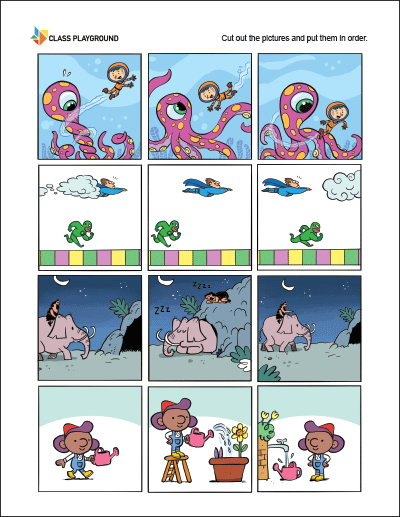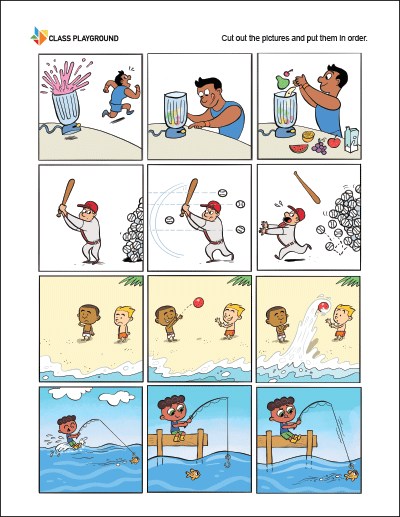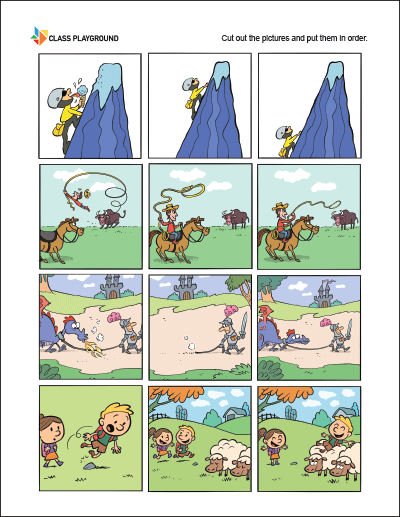What is Story Sequencing?
After reading a short story, can you remember what happened first? What happened in the middle of the story? How did the story end? These are questions you can ask children to help them practice story sequencing skills. Essentially, story sequencing means putting a narrative in order from what happened first to what happened last. In the classroom, story sequencing usually involves putting three or more pictures in order. It’s an important literacy skill that leads to a deeper understanding of storylines, plots, and other elements of stories.
Skills Involved in Story Sequencing
Story sequencing may seem like a very simple skill. However, it involves many important thought processes and skills such as:
- Logic
- Reading comprehension
- Retelling and summarizing
- Ordering from left to right
- Interpreting visual information
- And so much more!
When sequencing, children may be presented with several images that they need to put in order. They will need to take in the visual information and use logic to order the images. Children can often relate images to their own lives and experiences to help them discover the correct order. For example, if children see a picture of an ice cream cone on the ground and a child crying, they may think about how they would feel in that situation. They may also consider the fact that the child must have been happily eating the ice cream minutes earlier. This helps children consider the before and after of events. To sequence stories, children also need to be able to put pictures in order from left to right.
When practiced after reading a story, story sequencing also involves reading comprehension. Children can only put story events in order if they can remember the overall storyline. This means that children must construct a storyline in their heads, which is an important reading skill. Children also practice retelling the story and summarizing when talking about sequencing pictures.
Why Story Sequencing is Important
Through story sequencing activities, students practice important literacy skills. Story sequencing in itself is important because it helps students start to analyze storylines and also their own experiences in real life. Plus, children can also build their vocabularies when using sequencing and transition words.
Story sequencing also prepares children for reading and analyzing more complex narratives and plots. For example, some story sequences exhibit relationships such as cause and effect or a problem and a solution. With practice story sequencing, children will be more confident about identifying these story elements.
In addition, children can acquire the skills needed to write a narrative through story sequencing activities. Reading and writing are closely connected, so when students improve their understanding of stories, they write better stories. Furthermore, story sequencing can be used as a building block for writing. Children may struggle with the blank page and coming up with a plot. With story sequencing cards, students automatically have a topic and storyline to follow. This can help them build their skills as a writer and later come up with their own interesting storylines.
Connecting story sequences to other subject areas can also help build skills. For example, story sequencing can be related to ordering events in history, understanding timelines, recalling procedures in a scientific experiment, ordering life cycles, or remembering the steps of how to solve a math problem. With an understanding of story sequencing, students can support their learning in these areas.
Story Sequencing: How to Teach It
Story sequencing can be taught with or without a story that goes alongside it. All you need are a set of three or more pictures that go in a certain order. The activity is perfect for presenting to the whole class or a small group.
Without a story, story sequencing can use real or fictional events. It can help to start with real events with which children can identify. For example, one story sequencing activity may show the morning routine of a child in three frames. One picture shows the child in bed, the next shows the child eating breakfast, and finally, the child is shown getting on the school bus. Show the children the images out of order. Then, ask them to put the pictures in the correct order. Because children can relate to the events, it’s easy for them to put the events in order from first to last.
The process can be similar when presenting story sequencing alongside a story. It can be useful to start with a familiar story such as a fairytale. Present children with three pictures that show events from the beginning, middle, and end of the story. Then, ask the children to put the pictures in order.
As students become more proficient with story sequencing, more pictures can be added to the mix. The more pictures used, the more challenging it will be for children to put them in order. This can encourage children to re-read and reference the text to get the right answer.
Additional Activities Related to Story Sequencing
There are many follow-up activities that you can use related to story sequencing. Here are just a few ideas:
- Tell a Story: After children have put the story sequencing cards in order, ask them to tell or retell the story shown on the cards. This will encourage children to practice their oral story-telling skills and use new vocabulary words. Go even further by having students write out the story or sequence of events in detail.
- Draw Your Own Sequence: After reading a story, encourage students to create their own sequencing cards. Or, ask students to draw out sequence cards that show their morning routine, how they performed an experiment, or even how they prepared an ice cream sundae.
- Write a Sentence: Encourage children to write a sentence describing each sequence card. Children can work on using sequence words such as “First,” “Then,” and “Last.”
- Perform: Have students role-play or perform a short play that shows the story sequences. One idea would be to have students act out the scene as a “still life.” They simply stand in the corresponding positions with props to represent the scenes.
- Write a Pictures Only Book: Have children draw a book using only pictures. Ask students how they can convey information to the reader. How will they show emotions? How will readers tell a story using the picture?
- Turn it Into a Craft: Children can create a craft such as a story strip. A story strip involves drawing pictures of a story in frames on a page. Thread them through a “TV” before taping the pictures in a loop. Then, students can pull the pictures through the TV to tell the story.
Story Sequencing
Story sequencing is an important skill that children can work on as early as kindergarten! Through story sequencing lessons, children can practice many important literacy skills that will help them build on their abilities.






